Analysis and Monitoring of Maximum Solar Potential for Energy Production Optimization Using Photovoltaic Panels
Abstract
:1. Introduction
2. Literature Review
- ▪
- Photovoltaics is a renewable energy source, which means that the production of electricity using photovoltaic panels is not associated with the emission of greenhouse gases or the consumption of non-renewable resources.
- ▪
- The popularization of photovoltaics contributes to a significant reduction in carbon dioxide emissions, especially if it replaces traditional energy sources based on fossil fuels. This aligns with the “Green Deal” goals regarding climate neutrality.
- ▪
- The development of photovoltaics supports the overall increase in the share of electricity from renewable sources, which is a priority of the “Green Deal”. This promotes the transformation of the energy sector.
- ▪
- Photovoltaics enables energy production at the local level, especially thanks to installations on building roofs or smaller solar farms. This increases the energy independence of regions and supports local communities.
- ▪
- Photovoltaics can be used to charge electric vehicles, an integral part of the “Green Deal” strategy concerning the electrification of transport and reducing emissions in this sector.
- ▪
- Photovoltaics enriches smart energy grids, enabling efficient management of energy production, distribution, and consumption, which supports goals related to energy efficiency.
- ▪
- Investments in photovoltaics support the development of modern technologies and innovations in the field of energy storage, improving the flexibility and reliability of renewable sources.
- ▪
- Photovoltaics is an integral part of the pursuit of green production, especially in the industrial sector, where sustainable energy sources are key to minimizing the ecological footprint.
- ▪
- Limited resources—The challenge lies in the need to use energy sources that are not only durable but also sufficient to meet the growing global demand.
- ▪
- Environmental pollution—Conventional energy sources, such as fossil fuels, generate pollution and contribute to climate change. The challenge is to find alternatives that minimize the negative impact on the environment.
- ▪
- Need for modern technologies—Implementing sustainable energy sources requires developing and adapting modern technologies, which can be challenging due to investment costs and the need for continuous research and development.
- ▪
- Variable characteristics of renewable sources—Renewable energy sources, such as solar and wind energy, are variable in availability. The challenge is to develop effective energy storage systems to cope with fluctuating access.
- ▪
- Need for social acceptance—Effective energy transformation requires societal acceptance. The challenge is to persuade people to change habits and attitudes towards energy and to understand the benefits of sustainable sources.
- ▪
- Economic issues—The cost of investing in sustainable energy sources can be challenging, especially in the early stages of implementation. It is necessary to develop economically efficient models to enable the widespread adoption of sustainable solutions.
- ▪
- Variable regulations and energy policy—this results primarily from a lack of consistency in guidelines at the national and international levels. Coordination and cooperation between countries pose further challenges.
- ▪
- ▪
- ▪
- ▪
- ▪
- ▪
- ▪
- ▪
- ▪
- ▪
3. Materials and Methods
- In Poland, installations with single-axis trackers that track the movement of the sun in one plane are used in many photovoltaic projects. They allow you to increase the efficiency of the panels, especially in the spring and summer periods. However, advanced two-axis tracking systems are currently being tested, which can further increase the panels′ efficiency by optimizing the angle of sunlight throughout the day [56,57].
- In the United States, especially in states such as California and Nevada, where sunlight is very high, solar trackers are widely used in large photovoltaic farms, making it possible to significantly increase energy production compared to stationary systems [62].
- ▪
- the height of the sun above the plane of the earth (horizon) αs
- ▪
- solar azimuth ys,
- Geolocation measurement: The system starts by measuring the geolocation, which allows you to determine the location of the photovoltaic installation.
- Measuring the angle of incidence of sunlight: The algorithm then uses measurements of the angle of incidence of sunlight at a given place and time, which allows for determining the optimal angle of inclination of the panels to maximize solar energy absorption.
- Taking into account the change in the position of the sun: The algorithm takes into account the change in the position of the sun during the day and depending on the season, which allows you to constantly adjust the angle of the panels to maintain optimal exposure to solar rays.
- Tracking system use: The system uses these data to control a real-time tracking system that adjusts the panels’ tilt angle to optimize performance in changing lighting conditions.
- Panel temperature monitoring: The algorithm monitors the panel temperature to prevent overheating, which can negatively impact their performance.
- Application of the control algorithm: The control algorithm uses these data to continuously optimize the angle of the panels to maximize electricity production.
| Listing 1. An example of the clock algorithm for the location Gliwice, Poland. |
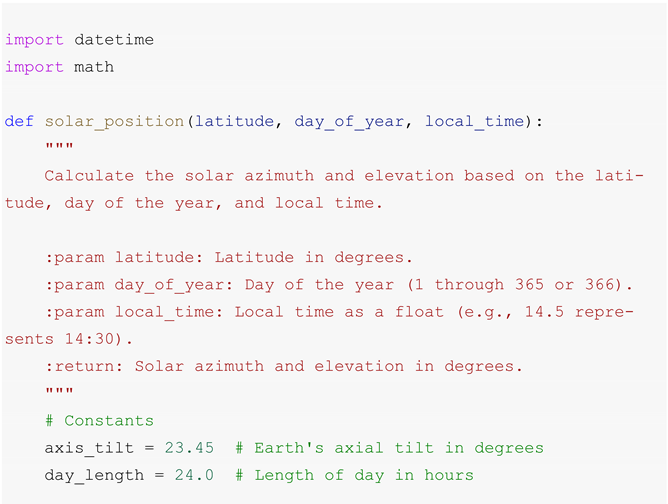 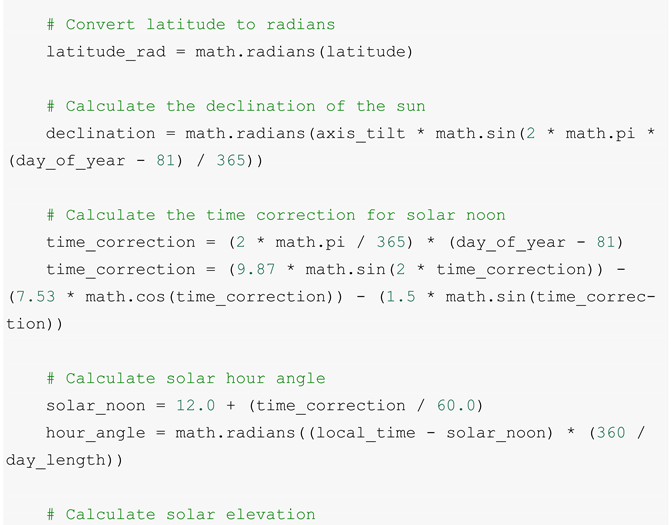   |
- optimization of the placement of photovoltaic panels to maximize exposure.
- conducting system performance analysis under different weather conditions.
- planning investments in solar energy based on real data on solar potential in a given region.
- Use of artificial intelligence: Implementing artificial intelligence technology to analyze data from the tracking system could enable more precise prediction of the optimal position of panels depending on forecast weather conditions.
- Energy consumption optimization: The tracking algorithm could be developed to take into account not only energy production but also energy demand at a given time. This allows the system to optimize energy production depending on current needs.
4. Conclusions
- Optimal geographical positioning: The study underscores the importance of precise geographical positioning for photovoltaic panels. Optimal orientation and tilt, informed by regional solar mapping, are crucial for maximizing energy capture from solar radiation.
- Innovative tracking systems: Implementing solar trackers, particularly those that adjust in two axes, can substantially increase the efficiency of photovoltaic panels. The study demonstrates potential efficiency improvements, emphasizing the value of dynamic tracking systems over static installations.
- Impact of environmental factors: Environmental conditions, including temperature, solar light intensity, and atmospheric phenomena, significantly influence photovoltaic efficiency. The research highlights the need for systems that can adapt to these variable factors to maintain optimal performance.
- Technological advancements: Advancements in photovoltaic technology, including the development of new materials and system designs, are pivotal for enhancing energy conversion efficiency. The study points to ongoing innovation as a key driver in the evolution of photovoltaic systems.
- Monitoring and control systems: A Raspberry Pi-based monitoring and control system is proposed, utilizing a clock algorithm to optimize the orientation and angle of inclination of PV panels. This system is designed to adjust the panels’ position in real-time, accounting for the sun’s trajectory and environmental conditions.
- Python script for solar positioning:
- ○
- The Python script developed as part of this research represents a practical tool for calculating the sun’s position in the sky, which is essential for the optimal alignment of photovoltaic panels.
- ○
- By utilizing basic astronomical equations, the script provides a method for determining the azimuth and elevation of the sun, enabling the solar tracker to adjust the panels accordingly.
- ○
- The script’s design allows easy integration with existing photovoltaic systems and can be adapted for various geographical locations and system scales.
- ○
- As a simplified model, the script serves as a foundation for more complex algorithms that could incorporate additional environmental variables and predictive analytics.
Author Contributions
Funding
Data Availability Statement
Conflicts of Interest
References
- Manowska, A.; Nowrot, A. The Importance of Heat Emission Caused by Global Energy Production in Terms of Climate Impact. Energies 2019, 12, 3069. [Google Scholar] [CrossRef]
- Khushoo, M.; Sharma, A.; Kaur, G. Materials Today: Proceedings DC microgrid—A short review on control strategies. Mater. Today Proc. 2022, 71, 362–369. [Google Scholar] [CrossRef]
- Odou, O.D.T.; Bhandari, R.; Adamou, R. Hybrid off-grid renewable power system for sustainable rural electrification in Benin. Renew. Energy 2020, 145, 1266–1279. [Google Scholar] [CrossRef]
- Pujari, H.K.; Rudramoorthy, M. Optimal design and techno-economic analysis of a hybrid grid-independent renewable energy system for a rural community. Int. Trans. Electr. Energy Syst. 2021, 31, e13007. [Google Scholar] [CrossRef]
- Ghaithan, A.M.; Mohammed, A.; Al-Hanbali, A.; Attia, A.M.; Saleh, H. Multi-objective optimization of a photovoltaic wind grid connected system to power reverse osmosis desalination plant. Energy 2022, 251, 123888. [Google Scholar] [CrossRef]
- Yang, Y.; Bremner, S.; Menictas, C.; Kay, M. Modelling and optimal energy management for battery energy storage systems in renewable energy systems: A review. Renew. Sustain. Energy Rev. 2022, 167, 112671. [Google Scholar] [CrossRef]
- Bluszcz, A. The Emissivity and Energy Intensity in EU Countries—Consequences for the Polish Economy. In Proceedings of the Energy and Clean Technologies. Recycling, air Pollution and Climate Change, Sofia, Bulgaria, 1–7 July 2018; Volume 18, pp. 631–638. [Google Scholar]
- Brodny, J.; Tutak, M. Analyzing Similarities between the European Union Countries in Terms of the Structure and Volume of Energy Production from Renewable Energy Sources. Energies 2020, 13, 913. [Google Scholar] [CrossRef]
- Bluszcz, A. European Economies in terms of energy dependence. Qual. Quant. 2017, 51, 1531–1548. [Google Scholar] [CrossRef]
- Olasehinde-Williams, G.; Özkan, O.; Akadiri, S.S. Effects of climate policy uncertainty on sustainable investment: A dynamic analysis for the U.S. Environ. Sci. Pollut. Res. 2023, 30, 55326–55339. [Google Scholar] [CrossRef]
- Gawlik, L. The Polish power industry in energy transformation process. Min. Econ. 2018, 31, 229–237. [Google Scholar] [CrossRef]
- Iyke, B.N. Climate change, energy security risk, and clean energy investment. Energy Econ. 2024, 129, 107225. [Google Scholar] [CrossRef]
- Manowska, A.; Tobór-Osadnik, K.; Wyganowska, M. Economic and social aspects of restructuring Polish coal mining: Focusing on Poland and the EU. Resour. Policy 2017, 52, 192–200. [Google Scholar] [CrossRef]
- Jonek-Kowalska, I. Challenges for long-term industry restructuring in the Upper Silesian Basin. What has Polish coal mining achieved and failed from a twenty—Year perspective? Resour. Policy 2015, 44, 135–149. [Google Scholar] [CrossRef]
- Hąbek, P.; Wolniak, R. Assessing the quality of corporate social responsibility reports; the case of reporting practices in selected European Union member states. Qual. Quan. 2016, 50, 399–420. [Google Scholar] [CrossRef] [PubMed]
- Grabowska, S. Improvement of the Heat Treatment Process in the Industry 4.0 Context. METAL 2018. In Proceedings of the 27th International Conference on Metallurgy and Materials, Brno, Czech Republic, 23–25 May 2018; pp. 1985–1990. [Google Scholar]
- Brzychczy, E. An overview of data mining and process mining applications in underground mining. Min. Eng. 2019, 21, 301–314. [Google Scholar] [CrossRef]
- Igeland, F.; Schroeder, L.; Yahya, M.; Okhrin, Y.; Uddin, G.S. The energy transition: The behavior of renewable energy stock during the times of energy security uncertainty. Renew. Energy 2024, 221, 119746. [Google Scholar] [CrossRef]
- Bluszcz, A. Multidimensional comparative analysis as a tool for assessing the level of development of energy markets in selected European countries. In World Multidisciplinary Earth Sciences Symposium WMESS; IOP Conference Series: Earth and Environmental Science; Institute of Physics Prague: Bristol, Czech Republic, 2020. [Google Scholar]
- Bluszcz, A.; Ranosz, R. The use of multidimensional exploration techniques to assess the similarity level of development of energy markets. Min. Eng. 2020, 21, 199–204. [Google Scholar] [CrossRef]
- European Green Deal, Europejski Zielony Ład. Available online: europa.eu (accessed on 27 November 2023).
- Allouhi, A.; Rehman, S.; Buker, M.S.; Said, Z. Recent technical approaches for improving energy efficiency and sustainability of PV and PV-T systems: A comprehensive review. Sustain. Energy Technol. Assess. 2023, 56, 103026. [Google Scholar] [CrossRef]
- Bubpharam, S.; Chenvidhya, D.; Chuangchote, S.; Chenvidhya, T.; Seapan, M. Quantifying the benefits of PV module shading for building heat gain reduction: A machine learning approach. Sustain. Energy Technol. Assess. 2023, 60, 103428. [Google Scholar] [CrossRef]
- Polman, A.; Knight, M.; Garnett, E.C.; Ehrler, B.; Sinke, W.C. Photovoltaic materials: Present efficiencies and future challenges. Science 2016, 352, aad4424. [Google Scholar] [CrossRef]
- Huang, H.; Zhang, X.; Gui, R.; Zhao, C.; Guo, J.; Maung, Y.M.; Yin, H.; Ma, W.; Yuan, J. High-Efficiency Perovskite Quantum Dot Photovoltaic with Homogeneous Structure and Energy Landscape. Adv. Funct. Mater. 2023, 33, 2210728. [Google Scholar] [CrossRef]
- Omar, F.A. A new approach for improving the efficiency of the indirectly coupled photovoltaic-electrolyzer system. Int. J. Hydrogen Energy 2023, 48, 8768–8782. [Google Scholar] [CrossRef]
- Bernardo, L.R.; Perers, B.; Hakansson, H.; Karlsson, B. Performance evaluation of low concentrating photovoltaic/ thermal systems: A case study from Sweden. Sol. Energy 2011, 85, 1499–1510. [Google Scholar] [CrossRef]
- Kim, D.-E.; Lee, H.-J.; Moon, H.-R.; Shon, J.-G. Improving the efficiency of a photovoltaic system using a hybrid control method based on a DPP structure. J. Electr. Eng. Technol. 2021, 16, 625–632. [Google Scholar] [CrossRef]
- Hadroug, N.; Iratni, A.; Hafaifa, A.; Boudjemline, A.; Alshammari, O.S.; Jerbi, H.; Colak, I.; Chen, X. Energy Efficiency Improvement in Photovoltaic Installation Using a Twin-Axis Solar Tracking Mechanism with LDR Sensors Compared with Neuro-Fuzzy Adaptive Inference Structure. J. Electr. Eng. Technol. 2023, 18, 2943–2967. [Google Scholar] [CrossRef]
- Rezk, H.; Harrag, A. A robust type-2 fuzzy logic-based maxi mum power point tracking approach for thermoelectric generation systems. Int. J. Energy Res. 2021, 45, 18066–18080. [Google Scholar] [CrossRef]
- Khan, M.J. A Novel hybrid maximum power point tracking controller based on artificial intelligence for solar pho tovoltaic system under variable environmental conditions. J. Electr. Eng. Technol. 2021, 16, 1879–1889. [Google Scholar] [CrossRef]
- Singh, U.P.; Chandra, S. Optimal cleaning schedule in solar PV using the biography-based helianthus optimization enabled coupled deep network. Sol. Energy 2023, 266, 112138. [Google Scholar] [CrossRef]
- Cheema, A.; Shaaban, M.F.; Ismail, M.H. A novel stochastic dynamic modeling for photovoltaic systems considering dust and cleaning. Appl. Energy 2021, 300, 117399. [Google Scholar] [CrossRef]
- Lin, X.; Zhou, W.; Li, S.; Fang, H.; Fu, S.; Xu, J.; Huang, J. Photodegradation of Sulfamethoxazole and Enrofloxacin under UV and Simulated Solar Light Irradiation. Water 2023, 15, 517. [Google Scholar] [CrossRef]
- Eshghi, M.; Allahyari, S. Construction of a magnetic BiOBr-rGO-ZnFe2O4 heterojunction photocatalyst for refinery wastewater treatment under simulated solar light. Sol. Energy 2023, 264, 112062. [Google Scholar] [CrossRef]
- Mollahasanoglu, M.; Okumus, H.I. Performance Evaluation of the Designed Two-Axis Solar Tracking System for Trabzon. IETE J. Res. 2021, 69, 5338–5350. [Google Scholar] [CrossRef]
- Khudair, Y.Y.; Hasan, A.B.; Mahdi, H.S. Performance efficiency effectiveness of incidence angle of concave trough solar concentrator. Mater. Today Proc. 2023. [Google Scholar] [CrossRef]
- Abdeldjebar, R.; Elmir, M.; Douha, M. Study of the performance of a photovoltaic solar panel by using a nanofluid as a cooler. Latv. J. Phys. Tech. Sci. 2023, 60, 69–84. [Google Scholar] [CrossRef]
- Alghamdi, H.; Maduabuchi, C.; Albaker, A.; Almalaq, A.; Alsuwian, T.; Alatawi, I. Machine Learning Performance Prediction of a Solar Photovoltaic-Thermoelectric System with Various Crystalline Silicon Cell Types. Int. J. Energy Res. 2023, 69, 1990593. [Google Scholar] [CrossRef]
- Sharifi Miavaghi, A.; Esmaeili, A. A Novel Method to Detect Partial Shadow Effects in Perovskite-Based Simulated Solar Cell System Faults. Micromachines 2023, 14, 832. [Google Scholar] [CrossRef] [PubMed]
- Salim, K.; Asif, M.; Ali, F.; Armghan, A.; Ullah, N.; Mohammad, A.-S.; Al Ahmadi, A.A. Low-Stress and Optimum Design of Boost Converter for Renewable Energy Systems. Micromachines 2022, 13, 1085. [Google Scholar] [CrossRef]
- Hao, X.; Shan, S.; Gao, N.; Chen, G.; Wang, Q.; Gu, T. Performance analysis of a novel combined cooling, heating and power system with solar energy spectral beam splitting. Energy Convers. Manag. 2023, 276, 116500. [Google Scholar] [CrossRef]
- Vijayan, D.S.; Koda, E.; Sivasuriyan, A.; Winkler, J.; Devarajan, P.; Kumar, R.S.; Jakimiuk, A.; Osinski, P.; Podlasek, A.; Vaverková, M.D. Advancements in Solar Panel Technology in Civil Engineering for Revolutionizing Renewable Energy Solutions—A Review. Energies 2023, 16, 6579. [Google Scholar] [CrossRef]
- Li, Y.; Xu, X.; Bao, D.; Rasakhodzhaev, B.; Jobir, A.; Chang, C.; Zhao, M. Research on Hydrogen Production System Technology Based on Photovoltaic-Photothermal Coupling Electrolyzer. Energies 2023, 16, 7982. [Google Scholar] [CrossRef]
- Zhang, Q.; Chang, Z.; Fu, M.; Nie, F.; Ren, T.; Li, X. Thermal performance analysis of an integrated solar reactor using solid oxide electrolysis cells for hydrogen production. Energy Convers. Manag. 2022, 264, 115762. [Google Scholar] [CrossRef]
- Amirthan, T.; Perera, M.S.A. Underground hydrogen storage in Australia: A review on the feasibility of geological sites. Int. J. Hydrogen Energy 2023, 48, 4300–4328. [Google Scholar] [CrossRef]
- Gbadamosi, A.O.; Muhammed, N.S.; Patil, S.; Shehri, D.A.; Haq, B.; Epelle, E.I.; Mahmoud, M.; Kamal, M.S. Underground hydrogen storage: A critical assessment of fluid-fluid and fluid-rock interactions. J. Energy Storage 2023, 72, 108473. [Google Scholar] [CrossRef]
- Zhang, J.W.; Deng, W.; Ye, Z.; Diaham, S.; Putson, C.; Zhou, X.; Hu, J.; Yin, Z.; Jia, Z. Aging phenomena of backsheet materials of photovoltaic systems for future zero-carbon energy and the improvement pathway. J. Mater. Sci. Technol. 2023, 153, 106–119. [Google Scholar] [CrossRef]
- Li, X.; Aftab, S.; Abbas, A.; Hussain, S.; Aslam, M.; Kabir, F.; Hisham, S.M.; Abd-Rabboh, H.S.; Hegazy, H.H.; Xu, F.; et al. Advances in mixed 2D and 3D perovskite heterostructure solar cells: A comprehensive review. Nano Energy 2023, 118, 108979. [Google Scholar] [CrossRef]
- Shubbak, M.H. The technological system of production and innovation: The case of photovoltaic technology in China. Res. Policy 2019, 48, 993–1015. [Google Scholar] [CrossRef]
- Hossain, M.S.; Abboodi Madlool, N.; Al-Fatlawi, A.W.; El Haj Assad, M. High Penetration of Solar Photovoltaic Structure on the Grid System Disruption: An Overview of Technology Advancement. Sustainability 2023, 15, 1174. [Google Scholar] [CrossRef]
- Nwokolo, S.C.; Obiwulu, A.U.; Amadi, S.O.; Ogbulezie, J.C. Assessing the Impact of Soiling, Tilt Angle, and Solar Radiation on the Performance of Solar PV Systems. Trends Renew. Energy 2023, 9, 121–137. [Google Scholar] [CrossRef]
- Jathar, L.D.; Ganesan, S.; Awasarmol, U.; Nikam, K.; Shahapurkar, K.; Soudagar, M.; Elahi, M.; Fayaz, H.; El-Shafay, A.S.; Kalam, M.A.; et al. Comprehensive review of environmental factors influencing the performance of photovoltaic panels: Concern over emissions at various phases throughout the lifecycle. Environ. Pollut. 2023, 326, 121474. [Google Scholar] [CrossRef]
- Wiatr, J. Systemy Fotowoltaiczne: Projektowanie, Budowa, Zagrożenia Pożarowe Oraz Ich Neutralizacja. Instalacja Systemów PV na Stacjach Paliw Płynnych i Gazowych”; Elektro.info: Warszawa, Poland, 2022. [Google Scholar]
- Sawicki, H.; Piotrowski, R. Zaprojektowanie, wykonanie i sterowanie panelem słonecznym. Rynek Energii 2019, 3, 67–75. [Google Scholar]
- Zaik, K.; Werle, S. Solar and wind energy in Poland as power sources for electrolysis process—A review of studies and experimental methodology. Int. J. Hydrogen Energy 2023, 48, 11628–11639. [Google Scholar] [CrossRef]
- Kakoulaki, G.; Kougias, I.; Taylor, N.; Dolci, F.; Moya, J.; Jäger-Waldau, A. Green hydrogen in Europe—A regional assessment: Substituting existing production with electrolysis powered by renewables. Energy Convers. Manag. 2021, 228, 113649. [Google Scholar] [CrossRef]
- Olczak, P. Evaluation of degradation energy productivity of photovoltaic installations in long-term case study. Appl. Energy 2023, 343, 121109. [Google Scholar] [CrossRef]
- Hosouli, S.; Gomes, J.; Loris, A.; Pazmiño, I.-A.; Naidoo, A.; Lennermo, G.; Mohammadi, H. Evaluation of a solar photovoltaic thermal (PVT) system in a dairy farm in Germany. Sol. Energy Adv. 2023, 3, 100035. [Google Scholar] [CrossRef]
- Segura, E.; Belmonte, L.M.; Morales, R.; Somolinos, J.A. A Strategic Analysis of Photovoltaic Energy Projects: The Case Study of Spain. Sustainability 2023, 15, 12316. [Google Scholar] [CrossRef]
- Fernández-Gonzxaxlez, R.; Arce, E.; Garza-Gil, D. How political decisions affect the economy of a sector: The example of photovoltaic energy in Spain. Energy Rep. 2021, 7, 2940–2949. [Google Scholar] [CrossRef]
- Wang, Y.; Millstein, D.; Mills, A.D.; Jeong, S.; Ancell, A. The cost of day-ahead solar forecasting errors in the United States. Sol. Energy 2022, 231, 846–856. [Google Scholar] [CrossRef]
- Bugała, A.; Frydrychowicz-Jastrzębska, G. Pozycjonowanie modułu fotowoltaicznego w jednoosiowym układzie nadążnym. Electr. Eng. 2015. Available online: https://yadda.icm.edu.pl/baztech/element/bwmeta1.element.baztech-10cf8ffc-c2fc-4c68-98a3-f674611d9dbd/c/bugala_artur_pozycjonowanie_81_2015.pdf (accessed on 27 November 2023).
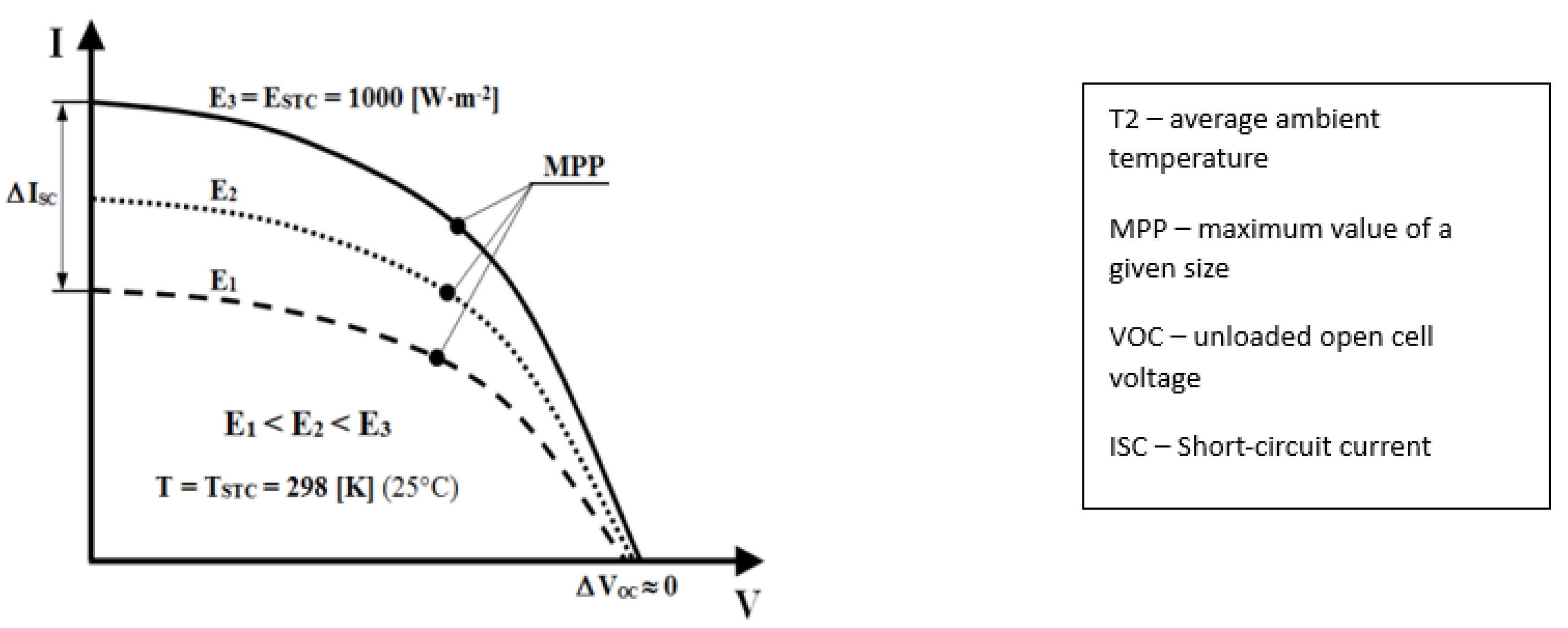


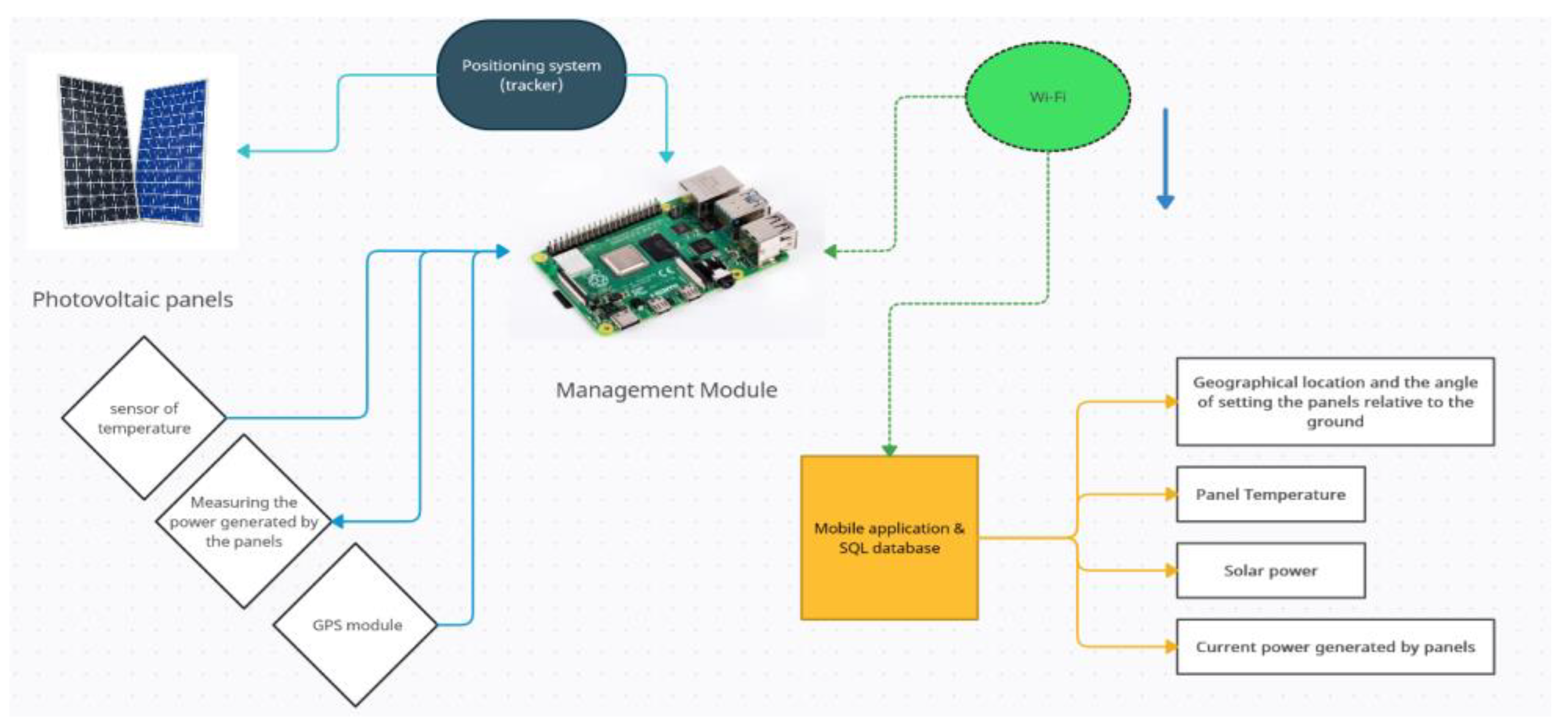


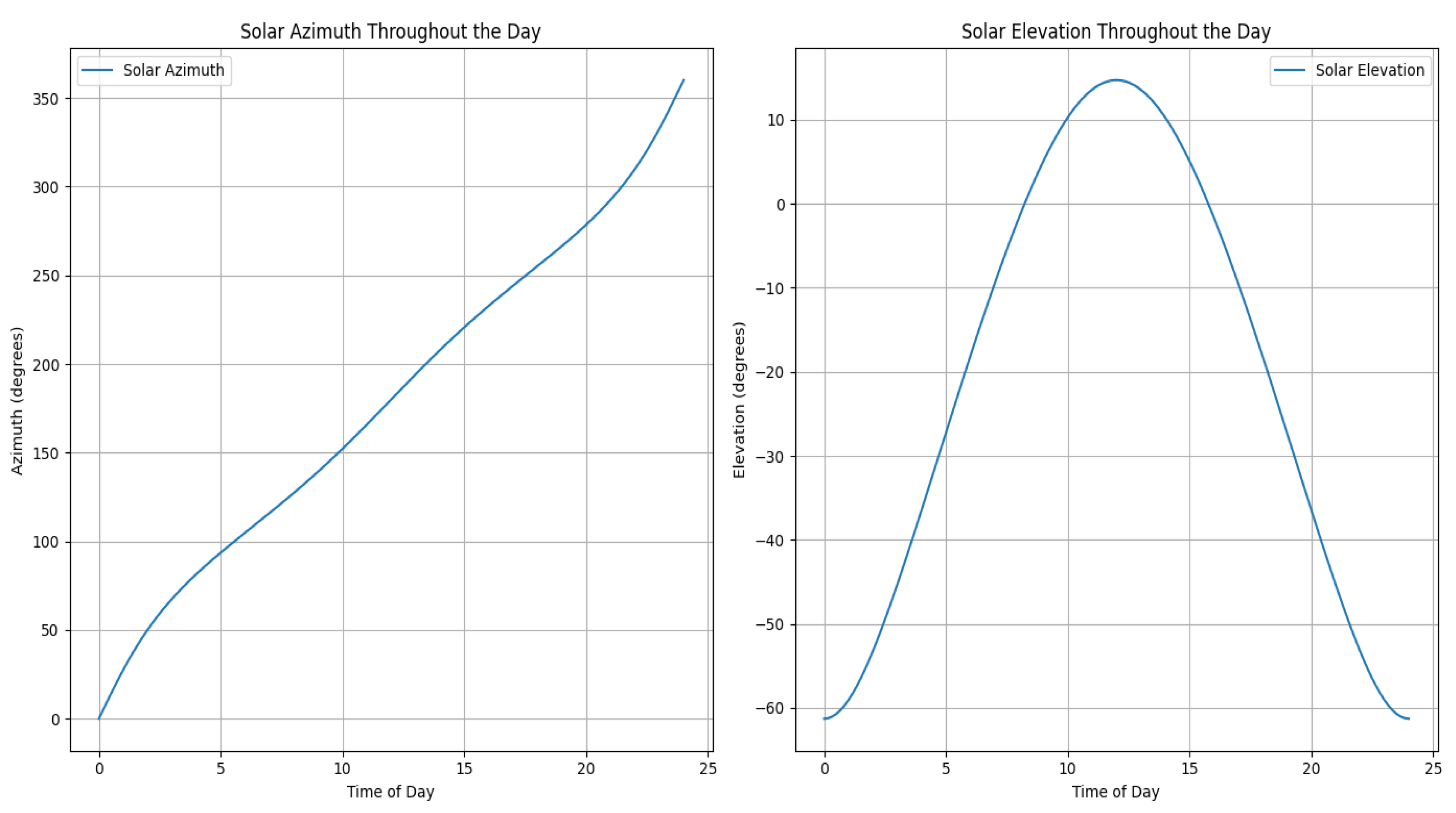
| Methods/Models | Source |
|---|---|
| In the article by Albert Polman et al., the authors review the current state of photovoltaic (PV) materials and their efficiencies, providing a comprehensive overview of the landscape as of 2016. They discuss the various types of PV technologies available, including crystalline silicon, thin films, and emerging materials like perovskites. The authors identify key challenges that need to be addressed to further improve efficiencies and reduce costs, such as enhancing light absorption, minimizing energy losses, and improving the stability of PV materials. | [24] |
| In the study by Fuad Alhaj Omar, a novel methodology is introduced to enhance the efficiency of indirectly coupled photovoltaic-electrolyzer systems, which are pivotal for hydrogen production. The research focuses on optimizing the interface between the PV array and the electrolyzer to maximize the overall system efficiency. By employing a new maximum power point tracking (MPPT) technique, the system can adapt to changing solar conditions and ensure that the PV array operates at its most efficient point. The proposed approach also includes a novel energy management strategy that dynamically adjusts the operation of the electrolyzer in response to the variable power output from the PV array. | [26] |
| In the study conducted by Bernardo et al., the performance of low concentrating photovoltaic/thermal (PV/T) systems, which simultaneously generate electrical and thermal energy, was evaluated. A case study was carried out in Sweden, where climate poses unique challenges for PV/T technology due to variable sunlight exposure and low temperatures. The findings indicate that PV/T systems can be effective in moderate latitudes, providing a stable source of electrical and thermal energy. This research highlights the potential of integrating photovoltaic systems with thermal technologies as a means to enhance overall efficiency and utilization of renewable energy sources in diverse climatic conditions. | [27] |
| Kim et al. made strides in enhancing the efficiency of solar power systems by employing a hybrid control method that leverages differential power processing. This approach is designed to maximize system efficiency by swiftly targeting the zone of maximum power, taking into account various power conversion losses observed during their experimental research. | [28] |
| The research outlines two methods for real-time monitoring of solar power systems to capture the peak sunlight intensity. The first method involves a dual-axis solar tracking system that’s user-friendly and relies on Light-Dependent-Resistor sensors, coupled with specially designed printed circuit boards. The second method eschews these sensors in favor of artificial intelligence, specifically neuro-fuzzy systems with a self-adjusting reasoning framework. This AI-driven setup precisely follows the sun’s position throughout the year using solar tracking data on azimuth and elevation angles, leading to a significant boost in efficiency and performance thanks to the neuro-fuzzy adaptive reasoning. By implementing this advanced dual-axis solar tracking system, the study demonstrates a potential increase in energy efficiency for the solar installation under examination, with gains in solar energy capture of up to 24.44% over a stationary setup. | [29] |
| Khan and Pushparaj introduced a hybrid controller aimed at optimizing the maximum power point tracking for solar installations, even under changing environmental conditions. They utilized artificial intelligence, specifically fuzzy logic, to achieve a more stable and optimal performance of the solar power system. | [30] |
| Rezk and Harrag developed a robust system for tracking the maximum power point, using a more advanced type 2 fuzzy logic to accurately determine the best operating points as conditions fluctuate. | [31] |
Disclaimer/Publisher’s Note: The statements, opinions and data contained in all publications are solely those of the individual author(s) and contributor(s) and not of MDPI and/or the editor(s). MDPI and/or the editor(s) disclaim responsibility for any injury to people or property resulting from any ideas, methods, instructions or products referred to in the content. |
© 2023 by the authors. Licensee MDPI, Basel, Switzerland. This article is an open access article distributed under the terms and conditions of the Creative Commons Attribution (CC BY) license (https://creativecommons.org/licenses/by/4.0/).
Share and Cite
Manowska, A.; Dylong, A.; Tkaczyk, B.; Manowski, J. Analysis and Monitoring of Maximum Solar Potential for Energy Production Optimization Using Photovoltaic Panels. Energies 2024, 17, 72. https://doi.org/10.3390/en17010072
Manowska A, Dylong A, Tkaczyk B, Manowski J. Analysis and Monitoring of Maximum Solar Potential for Energy Production Optimization Using Photovoltaic Panels. Energies. 2024; 17(1):72. https://doi.org/10.3390/en17010072
Chicago/Turabian StyleManowska, Anna, Artur Dylong, Bogdan Tkaczyk, and Jarosław Manowski. 2024. "Analysis and Monitoring of Maximum Solar Potential for Energy Production Optimization Using Photovoltaic Panels" Energies 17, no. 1: 72. https://doi.org/10.3390/en17010072
APA StyleManowska, A., Dylong, A., Tkaczyk, B., & Manowski, J. (2024). Analysis and Monitoring of Maximum Solar Potential for Energy Production Optimization Using Photovoltaic Panels. Energies, 17(1), 72. https://doi.org/10.3390/en17010072







